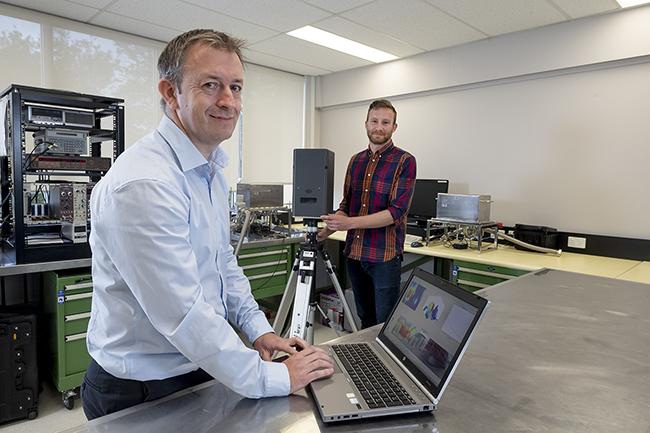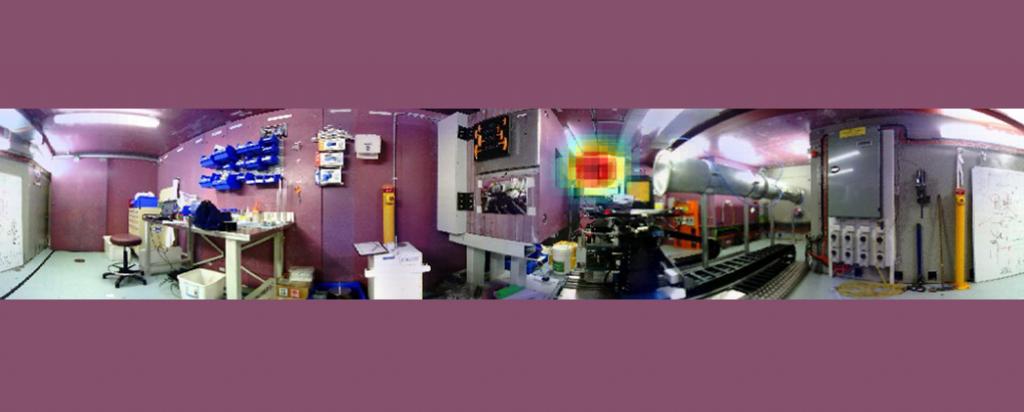

Published on the 22nd April 2020 by ANSTO Staff
Key Points
- Proof of concept research that led to the development of an advanced gamma-ray imaging technology has been published
- The approach, based on the theory of compressed sensing, led to the development of a technology that can quickly and safely image radiation from single or complex sources
- A team of experts in the detection and dosimetry of radiation carried out the research
The research behind the development of an advanced gamma-ray imaging system at ANSTO has been published in the Journal of Instrumentation.
With a launch of the new product planned for later this year, the paper describes the proof of concept for the approach used in the early development of the new system.
A team led by Dr David Boardman at ANSTO has invented and developed the spectroscopic gamma-ray imaging technology using the theory of compressed sensing.

Dr David Boardman and Dr Mathew Guenette are shown with a prototype of the device that was developed after the publication of this research
The novel technique is expected to generate a new class of fast, radiation imaging systems for applications in the nuclear, national security and defence industries, among other industries.
“The main advantage of the technology is a reduction in the number of measurements required for both point and more complex gamma radiation sources,” said Boardman.
The theory of compressed sensing was developed following seminal work by researchers at Caltech, Stanford University and UCLA.
When an image is sparse in some way, relatively few measurements are required to reconstruct the most significant components.
“Gamma-ray images generated using other imaging methodologies use a significant amount of their detection volume and/or time observing regions where the gamma-ray source is not located,” said Boardman.
As an example, the established raster scanning method has a single detector that takes discrete samples across a scene sequentially, while a pinhole camera has an array of detectors that sample the scene simultaneously.
In the described setup, a single detector and randomly patterned masks are used to sequentially, and non-adaptively, sample a different 50 per cent of the scene.
At any particular time, the detector sees 50 per cent of the scene.
The paper has experimentally demonstrated the imaging of point sources and extended sources with only a fraction of the measurements normally required by traditional imaging methods.
The imaging technique was tested on two point sources (241 Am and 133Ba) that were randomly placed within the scene plane. Reconstructed images of both 241 Am and 133Ba could be obtained from 25 measurements, which is just 10 per cent of the number of measurements traditionally required to produce a 16 x 16 pixel image.
This is an important result as a wide range of existing applications only require the imaging of point sources.
The imaging technique was also evaluated on a complicated extended source of 99Mo/99mTc in the shape of an ‘A’ and 67Ga in the shape of an ‘X’. Reconstructed images of the 99mTc and 67Ga were generated with 85 and 128 measurements. The former represents 33 per cent of the number of measurements traditionally required to produce a 16 x 16 pixel image and the latter, which had better image quality, represents 50 per cent.
“A significant advantage of the compressive gamma-ray imaging approach is that we can quickly image radiation with just a single-pixel detector,” said Boardman
Co-authors on the paper comprised Boardman, Adam Sarbutt, Alison Flynn and Mathew Guenette.
The project team is now finalising the technical development and market testing phase in order to launch the first product.
“The team is working closely with initial customers in Australia and internationally, to gain further market validation and user feedback,“ said Rosanne Robinson, General Manager Business Development and Commercialisation.
New customer demonstrations are scheduled for clients in Europe, Japan and the US later this year when the first market-ready product will be launched.
“We are finalising several contracts for organisations seeking to better support operational decision-making in national security and nuclear operations,” said Robinson.
DOI: https://doi.org/10.1088/1748-0221/15/04/P04014
The banner depicts an image of prompt gamma-rays (brightly coloured pixels) at the Dingo neutron tomography beamline, that was produced using the gamma-ray imaging technology.
For further information
Innovation and Commercialisation

